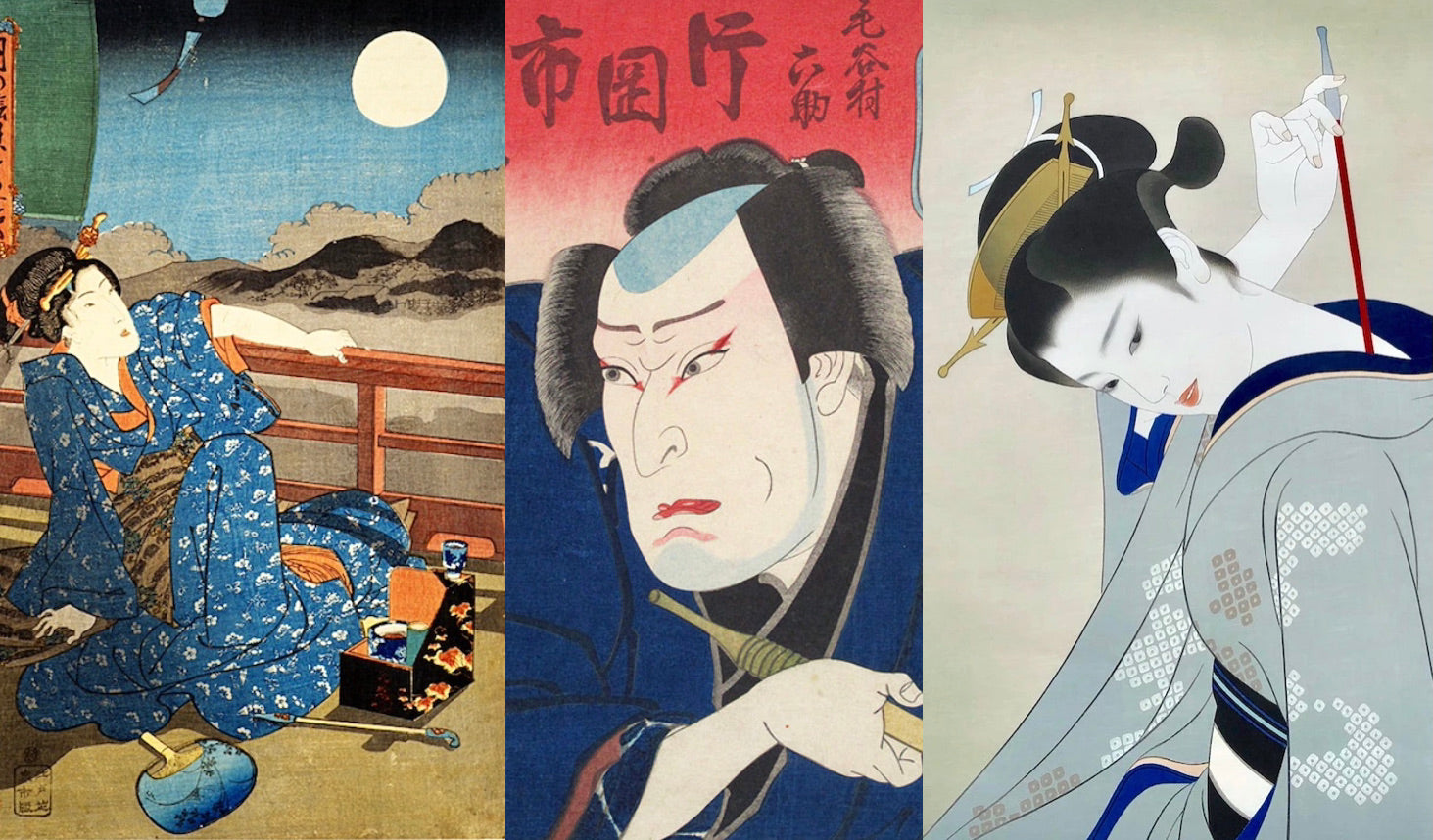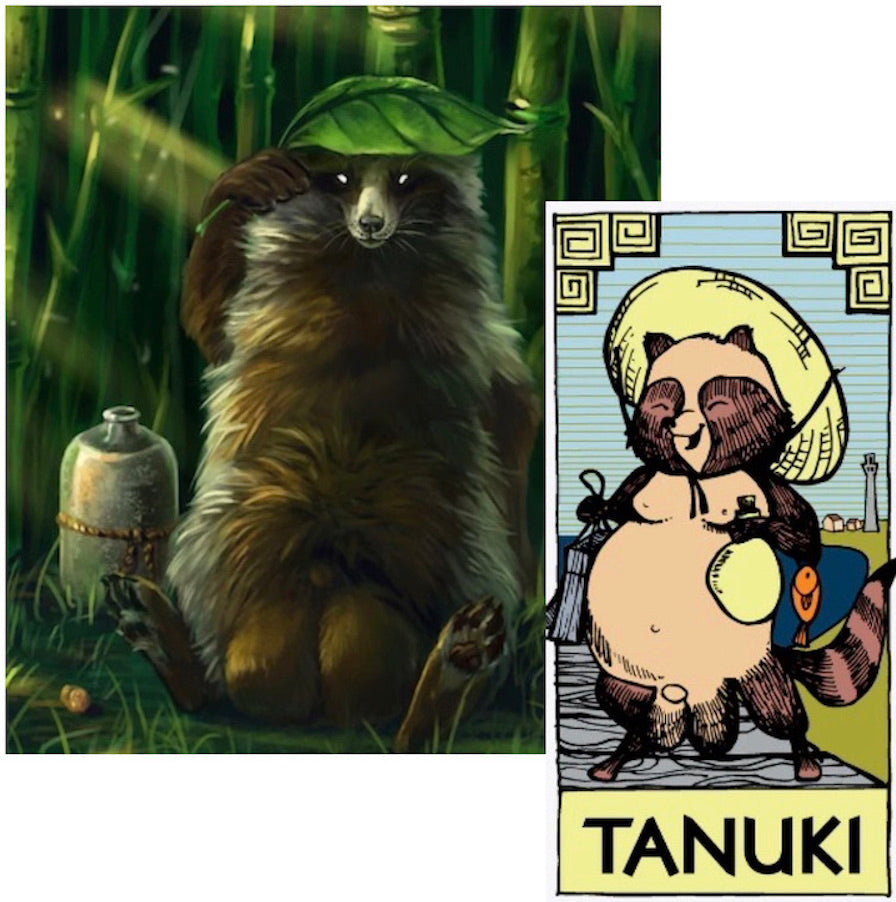Frogs have been represented for centuries in a variety of cultures as unique symbols, playing important roles in myth, folklore, fairytales, drawings, paintings, and sculptures. In Japan, the frog, (kaeru), is symbolic of fertility and good fortune, and as the word in Japanese means "to return”, frogs can be linked with things/or people returning to their place of origin. They are lucky to keep around, for frogs promise good fortune and friends, (which will at some point come back) so are carried by travelers to make sure they return safely from their journeys. In Japan, they are also given as thoughtful gifts, Omiyage, (a small lucky amulet/toggle type gift), to a friend who is going into a hospital for surgery and thus wishing them a successful return.
Among popular Japanese spiritual symbols, frogs were described as a symbol of Spring or Summer. These creatures are often used in poetry and art, which they are placed in a most favorable position, and venerated for their association with the cycle of nature and life. It is not uncommon to find ceramic, wood, lacquered hand-made frogs and stone being sold at temples or where visitors vacation.

Japanese Legends, Proverbs and Folklore
There are Japanese folk stories of giant toads that are two to three meters in height, and found high up on mountain streams. According to legend, they can breathe out great rainbows, and use the rainbows to slide prey into their mouths. They are also said to be able to walk on their hind legs. There are claims that they are particularly numerous in the mountains of the Suo region of Yamaguchi Prefecture.

These amphibious creatures also feature prominently in folklore, fairytales and fables. For example, "The Frog Prince”; "Frog and Mouse”; and the “Three Legged Toad who lives in the moon". The relationship between the moon and the frog has been a symbol attributed to various ancient cultures in numerous Asian countries. Celestial mythology has been passed on from generation to generation, and stories relating to the creation of the moon, the sun, and other heavenly bodies are still treasured today. Below are three most commonly referred to folk tales associated with frogs referred to in the Japanese culture.
The Tale of the Gallant Jiraiya | The Giant Snake Spirit takes over the Tsukikage Clan
In the first tale, from Sanskrit legend, the frog appears as a transformation of the hero, Jiraiya. The frog also appears in the form of a beautiful maiden, named Bheki, symbolizing the sun.
A long time ago, there existed an evil giant snake spirit that preyed on humans. This demonic snake spirit had ambitions to gain power over all of Japan. For that to happen, it decided to take control of the influential Tsukikage clan, whose feudal domain was Echigo province. Their leader – Tsukikage Gunryo Miyukinosuke – was also the regent of the Shogunate, (feudal government of Japan), and crucial to the evil snake’s plan.
On that fateful day, the snake spirit attached Lord Tsukikage Miyukinosuke. Had it not been for Orochimaru, who came out of nowhere to intervene, the Lord regent of Echigo would have died. Therefore, out of indebtedness, Lord Miyukinosuke adopted Orochimaru as a son. This was a huge mistake, for it sealed the fate of the Tsukikage, Ogata and Matsuura clans. Unbeknownst to Lord Miyukinosuke, the demonic snake spirit had possessed Orochimaru, and so he was merely a puppet from the start. The snake spirit and Orochimaru had staged the attack and rescue. So the Lord of Echigo effectively adopted the evil snake into his clan.
The lesson that the story teaches encourages one to get up and achieve something, or as they say “pull-up your socks”, and put some effort into moving forward.

The Traveling Pair of Frogs
In this second story, two silly frogs are discontent with their hometowns of Osaka and Kyoto. They meet each other on a mountain, and decide to help each other get to their destinations. Being silly little frogs, they mistakenly up up so they can only see where they came from. The Osaka frog though he faced Kyoto, but he could only see Osaka. The Kyoto frog did the same. The silly frogs mistakenly believed the towns were exactly the same. The tale speaks about our adage “the grass not always greener.” Each frog sets off thinking their destination will be better than their hometowns. This mistaken idea leads the frogs to be disappointed when they see their “destinations” on the mountain. The story warns us about how expectations and our easily mistaken senses can lead us astray.

The Child Becomes a Frog
The third Japanese legend, or proverb by Kotowaza reads; "Kaeru no ko wa kaeru to naru”, (The child of a frog becomes a frog). Interestingly, this Japanese proverb also exists in Western culture, loosely translated, it parallels the expressions, "Don't let it bother you", or "don't let it get under your skin". Here in a folktale illustrated in the woodblock prints shown below by Kawanabe Kyosai, one sees images and allusions to pre-twentieth century legends, or proverbs which may make it difficult for today's viewers to appreciate the significance. It depicts a fictitious scene in the form of caricatures with images of frogs, creatures generally considered messengers of good fortune in Japan. The two central figures are represented by a giant frog or toad, and a man holding a scroll in front of him. They are surrounded by a crowd of men and women who are either enjoying or laughing at the frog reading. Kyosai has also placed smaller frogs, and various objects associated with these amphibians, staged around lotus leaves, water, pots, an umbrella, and other artifacts to set the scene.
The equivalent of this idiom would be "like father, like son", or ”the apple doesn't fall far from the tree".

Works on Paper
Woodblock prints, also known as Nishiki-e is a type of Japanese multicolored woodblock printing; many with single and multi sheet images, (triptych), the technique is used primarily in ukiyo-e. It was invented in the 1760s, and perfected and popularized by the printmaker Suzuki Harunobu, who was widely recognized and iconic form of Japanese art, celebrated for their one-of-a-kind process, and distinctive aesthetic for which we find numerous Kaeru, (frog) themes. Additionally there were several Picture Books of Kaeru which consist of one-page pictures which were folded to make small narrative booklets for children. Among them was Japanese fairy tales series which presented a carefully organized selection of Japanese nursery tales, and the Best Japanese Picture Books, which is a series which were smaller and beautifully designed.
Other more complex books were made for adults of which several have associated poems for which the top kyōka poets of the day were invited to contribute. Japanese artists share their viewpoints freely and many times in combination with a fixed focus point, and in the aesthetic of Japanese fine art, often only the central motif of a visual image is expressed, or a part of the object depicted. A single image suggests the universe, a part suggests the whole, although it was not unusual to see robust and complex images, though Japan has a long history of narratives which employ images in collaboration with words.

Japanese Multi-Media Three-Dimensional Art
In China and Japan there is a Three-legged Toad in which its digits stand for the three lunar phases. Some see the three legs as an example of the relation of heaven, earth, and the ability to produce gold and silver coins from its mouth. Like the Rabbit-in-the-Moon, they represent the custodian of the elixir of immortality. During a lunar eclipse it is said that the frog/Toad “swallows the moon.”


Temples and Japanese Gardens Support the Symbol of Prosperity
The Japanese see many positive symbols of frogs, as they appear in large numbers when it rains. These same rains mark the start of farming seasons. This has led to the frog becoming a symbol of rain, fertility, and wealth, and is supposed to attract and protect wealth in homes and businesses. During this period, Japanese temples are extremely busy with visitors coming to give honor, praying to receive news of wealth and prosperity during the full moon.
Frog Symbolism in Dreams
The Japanese see a frog in their dreams, for they convey many different messages. It is said that hearing a frog sing in one’s dreams usually means fulfillment and gains. These gains could be monetary, romantically, or have to do with friendships in one’s physical and spiritual life. Stepping on a frog in a dream usually has to do with one seizing an opportunity in a nefarious way, and taking advantage of others. Dreams about consuming a frog could mean a prosperous and peaceful life, for a frog is a common cuisine item, especially in East Asia. However, for people who never eat frogs, a dream about eating them signifies a peaceful and fulfilling life. As we see in many temples, a stone frog usually indicates an opportunity for great prosperity in one’s work/business. Frogs then are a universal symbol of business wealth. A dream about frogs in water indicates an unexpected visit, or a desire for a trip/adventure, and finally, a dream of a frog in grass indicates a change in one’s romantic life: either hiding one’s feelings from someone, or one’s romantic life is about to take a turn for the worse or better depending on your actions. Remember that the frog represents wealth, and change, and beckons to a brighter tomorrow.
Frog Symbolism in Modern Japan
There is even a Japanese saying that that reads, Money is Frog, (Okane wa kaerudesu), which when said aloud sounds very similar to Money returns, for both are pronounced, (Okane ga kaeru). It is not unusual for Japanese travelers and students to carry little frog toggles encouraging the individuals in what ever endeavor they are involved, to successfully accomplish the task, and to create a financial success. Parents sensitize children through stories and folk tales throughout life, that the ability of the frog to metamorphose throughout its lifetime – from tadpole to frog – has cemented its place as a symbol of change. 



